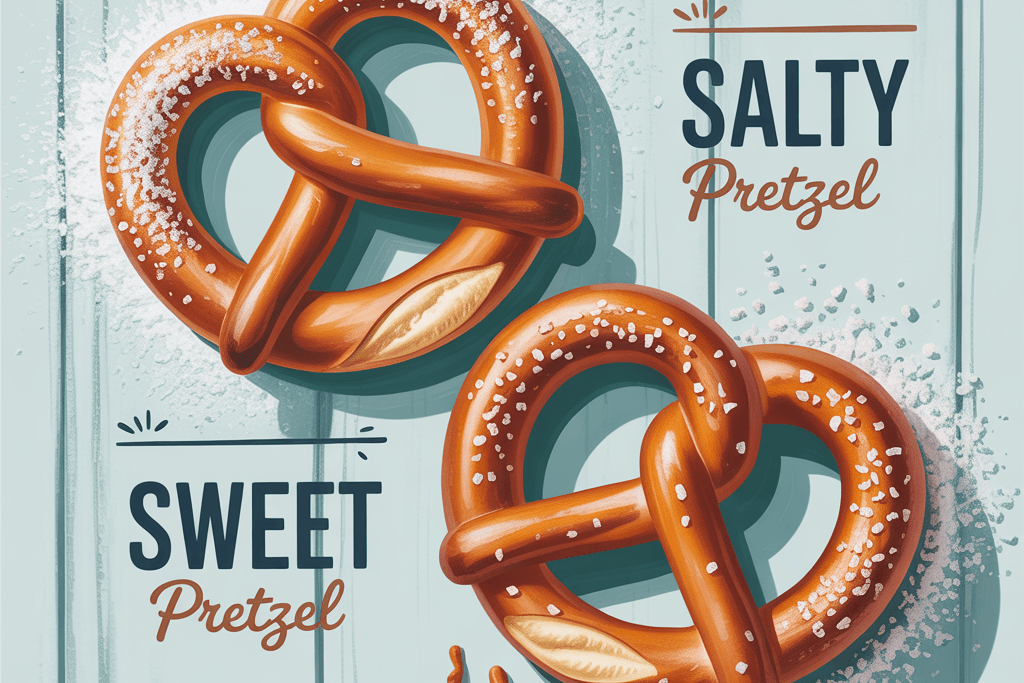Sweet vs. Salty Pretzels: A Delicious Journey Through History, Culture, and Flavor
Few baked goods are as universally recognized as the pretzel. With its distinctive twisted shape and golden-brown sheen, the pretzel has long been a symbol of both comfort food and culinary tradition. Yet within the world of pretzels lies a fascinating divide: sweet pretzels and salty pretzels. These two varieties may share the same doughy DNA, but they differ in preparation, taste, cultural meaning, and the occasions where they shine.

This article explores the histories, flavors, and cultural contexts of both sweet and salty pretzels. By the end, you’ll have a deeper appreciation for how this humble bread evolved into two distinct branches of culinary delight.
1. The Origins of the Pretzel
The pretzel’s history is steeped in myth and tradition. Scholars believe the pretzel was first developed in medieval Europe, likely by monks in the early Middle Ages. One legend attributes its creation to an Italian monk in the 6th or 7th century, who twisted leftover dough into the shape of arms folded in prayer. The three holes of the pretzel were said to symbolize the Holy Trinity, making the snack both a teaching tool and a reward for children who learned their prayers.
By the 12th century, pretzels had spread widely across Germany, where they became symbols of good luck and prosperity. In fact, pretzels were once hung on Christmas trees and used in Easter celebrations as tokens of renewal and hope.
While salty pretzels became the standard in Germany and Austria, sweeter versions developed alongside them, often in monasteries or during festive occasions when sugar and spices were more readily available. This divergence laid the foundation for the two main categories we enjoy today.
2. Traditional Preparation and Ingredients
Salty Pretzels
Classic salty pretzels, especially those from Bavaria, are made from wheat flour, yeast, water, and salt. What distinguishes them is the alkaline bath the dough undergoes before baking. Dipping the twisted dough in a lye solution (a tradition that dates back centuries) gives the pretzel its signature brown crust, chewy texture, and slightly bitter undertone. Coarse salt is then sprinkled on top, adding crunch and savory flavor.
Sweet Pretzels
Sweet pretzels are prepared with a similar dough base but take on additional ingredients like sugar, cinnamon, honey, or even vanilla. Instead of coarse salt, they may be coated with sugar crystals, cinnamon-sugar, icing, or chocolate. The alkaline dip may be skipped, replaced by egg washes that give a glossy, golden finish more akin to sweet breads or pastries.
Thus, while both start from a shared foundation, the preparation diverges at the finishing stage, where sweet toppings or salty sprinkles transform the pretzel into two different experiences.
3. Flavor Profiles and Textural Differences
- Salty Pretzels:
These pretzels are chewy, with a crisp outer shell that gives way to a soft interior. Their flavor is dominated by yeast and salt, with the lye bath imparting subtle bitterness that balances the dough’s natural sweetness. They are hearty and satisfying, ideal for pairing with mustard, cheese dips, or beer. - Sweet Pretzels:
Sweet pretzels lean into richness and indulgence. They may be softer and more tender, resembling pastries. Coatings like cinnamon sugar, icing, or chocolate shift the flavor toward dessert territory. Instead of bitterness, sweetness takes center stage, making them appealing to those with a sweet tooth.
4. Regional and Cultural Variations
Salty Pretzels Around the World
- Germany: The “Brezel” is iconic, especially in Bavaria, where it accompanies beer in beer gardens. These pretzels are often large and served with mustard or butter.
- United States: Pennsylvania Dutch immigrants popularized hard pretzels in the 19th century, creating the crunchy snack-food variety now sold in bags worldwide.
- Austria & Switzerland: Variations include larger, softer pretzels served with sausages, or pretzel rolls used for sandwiches.
Sweet Pretzels Around the World
- Germany & Austria: “Laugenbrezel” can be sprinkled with coarse sugar instead of salt, while holiday versions may include almonds or icing.
- Spain: A cousin of the pretzel, the “ensaimada,” shares similarities in shape and sweetness, though enriched with lard and sugar.
- United States: Sweet pretzels gained popularity in mall food courts, where chains introduced soft pretzels coated in cinnamon sugar or dipped in frosting.
5. Popular Toppings, Coatings, and Accompaniments
Salty Pretzels
- Toppings: Coarse salt (traditional), sesame seeds, poppy seeds, or even cheese.
- Accompaniments: Spicy mustard, beer cheese, or sliced sausages.
- Innovations: Stuffed pretzels with jalapeño cheese or ham.
Sweet Pretzels
- Toppings: Cinnamon sugar, pearl sugar, chocolate drizzle, powdered sugar.
- Accompaniments: Coffee, hot chocolate, or sweet cream cheese dips.
- Innovations: Pretzels stuffed with Nutella, peanut butter, or fruit compotes.
The toppings illustrate the divide between savory indulgence and dessert-like decadence.
6. Nutritional Considerations
Pretzels—sweet or salty—are carbohydrate-rich snacks. A typical salty pretzel is lower in fat and sugar but higher in sodium. Sweet pretzels, on the other hand, may be lower in salt but contain added sugars and fats (from toppings like icing or butter).
- Salty Pretzels:
A standard soft pretzel can contain 400+ calories, with as much as 2,000 mg of sodium (nearly the daily limit). - Sweet Pretzels:
These may contain similar calorie counts but derive more from sugars and added fats. Cinnamon-sugar pretzels or chocolate-dipped versions can easily surpass 500 calories.
For those monitoring sodium intake, sweet pretzels may be preferable; for those cutting sugar, salty pretzels are the better choice.
7. Occasions and Contexts for Enjoyment
- Salty Pretzels:
Traditionally tied to communal gatherings, salty pretzels are fixtures of Oktoberfest, sporting events, and beer halls. They are “snack as social glue,” encouraging sharing and pairing with savory foods. - Sweet Pretzels:
Sweet pretzels are more often enjoyed as desserts or treats, found at bakeries, fairs, or coffee shops. They are linked to comfort and indulgence, often bought as a personal treat rather than a communal snack.
This cultural division reflects how flavor influences social context: savory snacks lean communal, while sweet treats lean personal.
8. Modern Innovations and Contemporary Trends

Pretzels have evolved in surprising directions:
- Hybrid Creations: Pretzel croissants (“pretzants”) and pretzel bagels merge techniques from other breads.
- Health-Oriented Options: Whole grain pretzels, gluten-free recipes, and low-sodium or reduced-sugar versions target health-conscious consumers.
- Dessert Pretzels: Chocolate-covered pretzel rods blur the line between candy and bread, combining sweet and salty in one bite.
- Artisanal Pretzels: Craft bakeries experiment with unique toppings like matcha glaze, truffle salt, or chili-lime sugar.
The enduring adaptability of the pretzel ensures that both sweet and salty varieties remain relevant to modern tastes.
9. A Side-by-Side Comparison
| Aspect | Salty Pretzels | Sweet Pretzels |
|---|---|---|
| Flavor | Savory, yeasty, slightly bitter | Sweet, rich, dessert-like |
| Toppings | Coarse salt, seeds, cheese | Sugar, cinnamon, icing, chocolate |
| Texture | Chewy with crisp crust | Softer, pastry-like |
| Origins | Germany (Bavaria) | Germany/Austria (festive sweets) |
| Occasions | Beer gardens, sports, festivals | Cafés, fairs, dessert tables |
| Nutritional Notes | High sodium, lower sugar | High sugar, moderate sodium |
10. Conclusion: Two Branches of a Shared Tree
Sweet and salty pretzels share a common ancestry, yet their paths diverged to serve different palates, cultures, and occasions. Salty pretzels represent tradition, community, and savory satisfaction. Sweet pretzels embody indulgence, festivity, and the evolution of the pretzel into dessert culture.
Neither is inherently “better”—each offers its own pleasures. The true beauty of the pretzel lies in its versatility: whether you crave the satisfying chew of a salty Bavarian pretzel with mustard or the sugary comfort of a cinnamon-sugar pretzel with coffee, the pretzel continues to adapt, delight, and endure.
